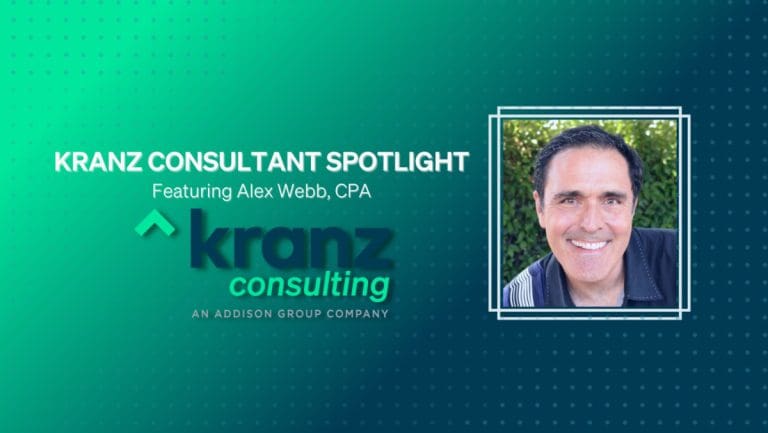
Meet one of our Consultant Controllers, Alex Webb! Alex has been a valuable part of Kranz Consulting for almost three years. His years of experience and passion for finance has allowed Kranz and our clients to not only succeed, but thrive. Get to know him better below!
Hometown: San Diego, California
Alma Mater: San Diego State University
Favorite things to do outside of the office: I love running and working out, making cocktails, visiting craft breweries and watching the best of the new TV series in this Golden Age of TV (“Succession” being my latest fixation).
How has your background impacted your experience as a consultant? I’ve spent much of my career as an auditor and then working in several Accounting and in FP&A organizations, which has enabled me to refine my interpersonal and business partnering skills with clients.
What’s a typical workday like for you? I find that in my current role there really is no “typical” workday. Every day is different, working on different projects, with different clients and with new priorities and challenges always popping up. It never gets boring and that’s what I love about consulting.
As part of a team that works 100% virtually, what technology or collaboration tools do you use to make your work life easier? “Microsoft Teams” is my “go to” too for meetings and I use instant messaging, whether in Teams or Slack, consistently.
What motivates you to wake up and go to work every day? Looking forward to a different day from yesterday….the challenge of juggling multiple priorities and deadlines.
What kind of work have you been doing? I’ve been working on a variety of projects both in the Accounting and Finance areas, including working on monthly closes, building forecast models, managing international compliance deliverables and ERP implementations (Coupa and Workday).
Where do you see the benefits? When a client expresses gratitude for what I’ve managed to deliver to them.
Linking data to finance and accounting, explain environments that have had lack of reporting infrastructure/inefficiencies and how have you brought organization and solutions-implementation: In my career, I’ve walked into several accounting and reporting environments that are chaotic, aren’t using system capabilities or have no processes in place. Because of this I’ve found deficiencies in such areas as managing company assets, in timely and accurate GAAP reporting and in gathering the right data points to enable management to chart future course. In these environments I often find there are simple and standard solutions. I may walk into a client and the first thing I see is no one is collecting receivables (!)…and it’s just a matter of setting a regular process for follow up. Or transactions are recorded with no emphasis or knowledge of GAAP and I will need to implement a regular close and reporting process or help a client set up standardized GAAP-compliant language in their contracts. Other times it’s about helping organize the client to forecast the variables in their business in a structured model. This is a more involved project requiring that the accounting systems have the right account structure to track the important revenue and expense variables for the business and obtaining an understanding of the business to build a model conducive to forecast future results.
What’s your process? When I first get onto a new client my first step is “getting the lay of the land.” Much like a soldier being parachuted behind enemy lines, I have to immediately assess the situation. Why am I here? Why has the client retained me? What are the client goals? What are their priorities? What are the pain points? What does the accounting environment look like? The way I initially obtain answers to these questions is by interviewing the client and their employees and asking these “Why” questions. One of my “go-to” questions is “What are your top three priorities for me on day one?” Then I start looking at their systems, existing processes and financial reporting, to be able to identify other priorities that are maybe in a client’s “blind spot.” From there I lay out the plan of what needs to be accomplished, in what priority order and in what steps over the course of the next week, month, quarter, etc. And finally it’s about execution and follow up, where I meet with the team on a weekly basis to determine status of steps and deliverables and plan for the next week.
